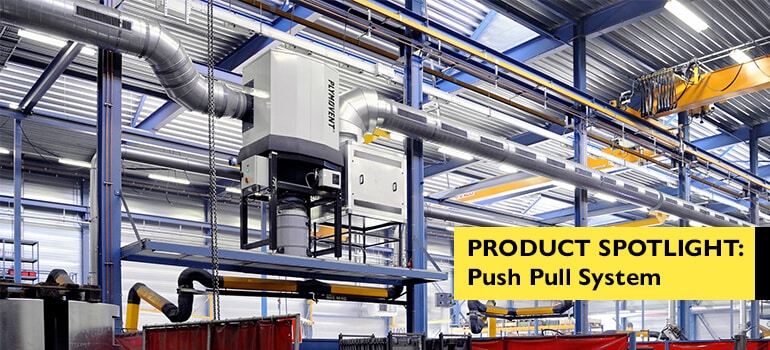The Plymovent Push-Pull system is a proven, effective solution for welding fume extraction that has been installed in best-in-class manufacturing facilities around the world. The modular design provides cost savings and all the benefits of a cleaner, healthier and safer work environment without significant changes to your workshop or facility. Instead, specific work zones can be designated for the addition of new ventilation.
Custom Designed Solution
Each Push-Pull system is specifically designed based on your facility’s layout and operations. Applications, manufacturing processes, operational procedures, as well as existing ventilation and airflow currents, volume, and more are all taken into account. This attention to detail ensures an optimal, effective solution to control welding fumes.
4-Stage Efficient System
The Push-Pull system operates in four stages:
1. Extraction – As welding fumes rise, an outlet duct pushes the smoke towards an inlet duct. This occurs in a controlled manner.
2. Filtration – The contaminated air is pulled through the extraction duct and into a self-cleaning filtration unit. Contaminants in the air are collected on filter media, which is automatically cleaned periodically with a pneumatic system. Captured particulates fall into a collection container at the bottom of the unit, and can be easily emptied.
3. Fan – Continuous extraction (pulling), filtration, and recirculation (pushing) process is generated by a fan unit that is specifically sized for your system needs.
4. Re-circulation – Once the particulate is filtered, the filtered clean air can be recirculated in your facility. By recirculating air instead of venting it outside, you can realize energy cost savings in climate-controlled environments. The recirculated air is also used to help control the movement of welding fumes by pushing them towards the extraction ducts.
Low Ownership Costs
A control system helps to monitor system flow, ensuring that optimal fan speeds are used under changing conditions. The control system will prevent fans from excessive output, shortening filter life span, reducing performance, and capturing efficiency and energy consumption. In some cases, a control system can provide savings of up to 60% in start-up conditions. These savings are carried over through recirculating expensively heated or cooled air within the facility.



Comments are closed.